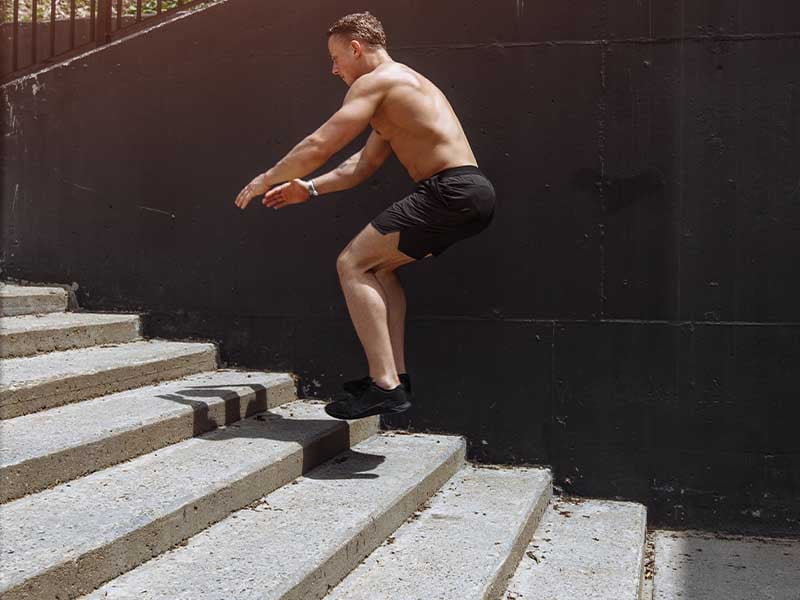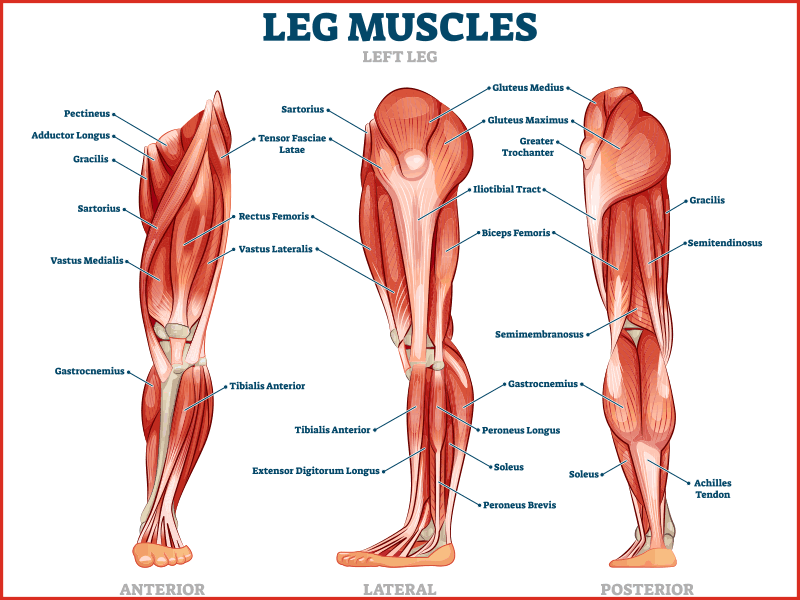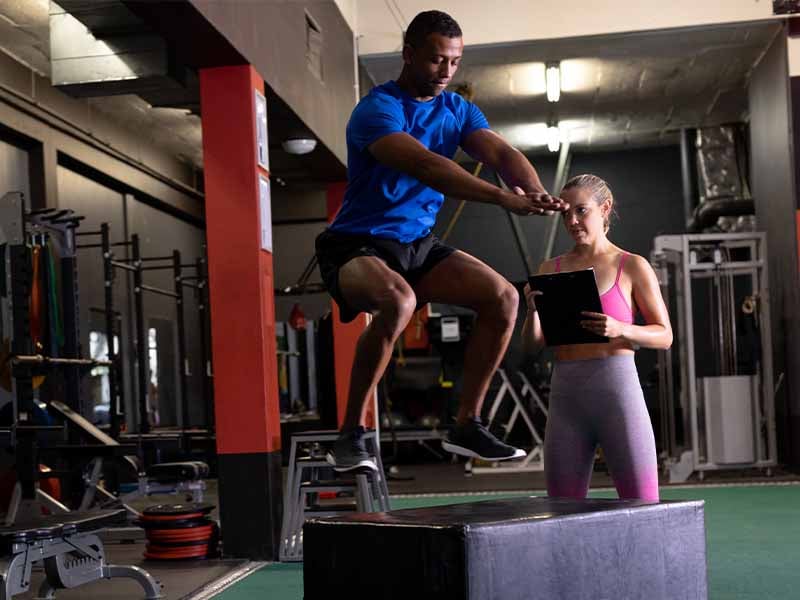
Box Jump Workout, Benefits, & Proper Form
Key Takeaways
- Like other plyometric exercises, box jumps cause your muscles to lengthen and shorten forcefully and repeatedly in the shortest time possible. This leads to increased power and explosiveness.
- When performed correctly, the box jump can make you stronger, faster, and leaner. We discuss the long term effects of frequent use of this exercise.
- There are many variations to the box jump that can be employed for specific workout purposes. Read on to find the version that is best for you.
Plyometric training is one of the best ways to boost explosive power, strength, and speed. After all, there’s a reason why football players, MMA fighters, and other athletes do plyometric exercises as part of their training regimen. When executed properly, these movements can improve your fitness and take your workouts to the next level.
Box jumps and other plyometric exercises cause your muscles to stretch and contract repeatedly in an explosive manner. This allows you to generate maximum force in the shortest time possible, leading to increased power and explosiveness.
As a bodybuilder or strength training enthusiast, you’re probably not doing box jumps regularly. You might be thinking that box jumps — and plyometrics, in general — are just for runners, sprinters, and other endurance athletes. But don’t jump to conclusions too quickly.

The box jump is one of the best exercises you can do for muscle strength, endurance, and overall conditioning. Plus, you’ll burn massive calories and get rid of stubborn fat.
Clinical evidence also suggests that plyometrics may increase functional joint stability and produce neuromuscular adaptations that reduce injury risk. At the same time, it may help correct muscular imbalances and improve knee health.
Like most exercises, box jumps and other plyometrics may lead to injury when performed with bad technique. It takes just one wrong move to fracture your wrist, knee, or elbow. That’s why using proper form is crucial.
Today we’ll show you how to perform box jumps safely, regardless of your fitness level. You’ll also find a list of box jump variations and training tips. Read on to learn more!
What Are Plyometrics and Why Do You Need Them?
Every guy wants a balanced physique and strong muscles. But you can’t achieve that by just lifting weights. You also need to train explosively and hit the right balance of strength and endurance work.
That’s where plyometrics can help.

This form of training is widely used in sports to increase speed, power, agility, and overall strength. When combined with strength exercises, it becomes even more effective for enhancing sprint, strength, and jump performance.
Plyometric exercises cause the muscles to lengthen and shorten forcefully and repeatedly. This generates an explosive reaction that increases power and speed during sports activities, explains a 2015 review published in the International Journal of Sports Physical Therapy.
What Researchers Say
As the researchers note, plyometrics not only enhance sports performance but also improve strength and conditioning. Some exercises may also be used for rehab. Russian and eastern European track and field athletes have used this training method for decades.
The same source notes that plyometric movements, especially those targeting the legs and glutes, may improve joint function, postural control, and running economy. Other key benefits include:
- Increased running speed and jump height
- Reduced sprint time
- Greater power and strength
- Improved neuromuscular control
- Lower injury risk
- Faster recovery from injuries
For example, a review in the Journal of Human Kinetics states that plyometrics are a safe, effective way to improve jump and sprint performance. Furthermore, they’re suitable for all ages and fitness levels, not just for seasoned athletes.
In clinical trials, seniors who performed plyometric exercises for one to 12 months experienced major improvements in bone health, postural stability, physical performance, and muscle strength. They also lost fat and gained lean mass. Only 1.4% of subjects incurred injuries.
As an integral component of plyometric training, box jumps are a great addition to your workout. Let’s see what’s so great about this exercise and how to incorporate it into your training regimen!
Build Explosive Strength with Box Jumps
Ask any athlete about his go-to plyo exercises, and he will mention box jumps at some point.
This explosive movement targets the lower body muscles and builds core strength while burning fat. Due to its dynamic nature, it raises your heart rate and boosts muscular endurance.
Box jumps are versatile, too. Depending on your training goals, you can adjust the box height and change your stance, foot positioning, workout intensity, and other variables.

For example, one way to boost your cardiovascular endurance and foot speed is to use a lower height box. Perform lots of reps as quickly as you can.
A high box, on the other hand, makes it easier to build explosive power and increase vertical jump — in this case, complete fewer reps and take longer breaks between sets,
Box jumping benefits your joints, heart, and muscles. With regular practice, it may help increase hip extension and flexion, leading to a greater range of motion.
This movement also trains your body to utilize oxygen more efficiently, which in turn, may improve your endurance and reduce blood pressure.
Note that box jumps are ideal for both cardiovascular and strength training. While this exercise won’t help you build mass, it may improve nervous system efficiency. As a result, you’ll get stronger overall and last longer in the gym.
All in all, this exercise can make you a better athlete. Plyometric training is clinically proven to improve running economy, jumping height, and explosive power. Plus, it will get your lower body tighter, leaner, and harder.
What Muscles Do Box Jumps Work?
This plyometric movement hits every single muscle in your legs, including your calves, hamstrings, and quads. At the same time, it strengthens your core and glutes.
Increased activation of the hamstrings, for instance, can increase running speed, maximal force output, and jumping ability.
Strong quads are essential for proper knee function and leg power. The glutes are involved in squats, lunges, leg presses, deadlifts, and other movements that promote hypertrophy and muscular strength.

Box jumps also hit your calf muscles. Strong calves make it easier to perform snatches, cleans, jerks, and other explosive movements. They also increase your stability when squatting, sprinting, and jumping.
Due to its explosive nature, this movement recruits type II (fast-twitch) muscle fibers and may increase your power and speed. Fast-twitch fibers are also responsible for muscle size and definition, so activating them will help you get leaner.
Additionally, the neurological adaptations that occur when you’re doing box jumps can be applied to squats, deadlifts, and other strength exercises. Your balance and coordination will improve too.
Like most exercises, box jumps can lead to painful injuries when performed with bad form. Falling off a box can happen to anyone. Common mistakes, such as skipping your warm-up and choosing a box that’s too high, can further increase your risk of injury.
As a rule of thumb, take the time warm up before doing box jumps — or any plyometric movement. It’s easy to sprain your ankle or pull a muscle if your body isn’t prepared for the workout ahead.
How to Do Box Jumps
The box jump is a great exercise as long as you do it right. If you’re a beginner, experiment with progressions to improve your jumping technique.
Squat jumps, for example, are a good starting point. As you practice this movement, you’ll learn how to brace your abs, land in a proper squat, and use your arms to generate force.
Next, move onto low-box jumps. Use a box that’s about six inches tall so that you can safely practice your landing. Planks, plie squats, back squats, lunges, and other lower body exercises can help prepare you for box squats, too.

When you feel comfortable doing low-box jumps, try box step-ups. Once you’re ready for your first box jump, ask a friend to spot you. Switch to higher boxes as you progress.
As a beginner, your best bet is to start with a box that’s about knee-high. Position yourself in front of it and take one large step backward. From here, follow these steps:
- Stand with your feet shoulder-width apart and your arms at your sides.
- Bend your knees into a quarter squat while bringing your arms back.
- Jump off the ground and swing your arms forward to generate force. Push your feet through the floor, trying to jump as high as you can.
- Land softly near the center of the box and absorb the jump with your knees.
- Step down and repeat. Ideally, try to jump and land in the same position.
Pro athletes and CrossFitters typically jump off the box — there’s nothing wrong about that. However, stepping down in a controlled manner is safer, especially for newbies. Jumping off a raised surface puts extra stress on the joints and may lead to injuries.
Tips for Better Box Jumps
Box jumps are not as complex as the pistol squat roll with a jump and other plyometrics, but it has its intricacies.

Keep these tips in mind:
- Start with a 12-inch or a 24-inch box. Generally, plyo boxes range in height from six to 42 inches, so there is plenty of room to progress based on your ability level.
- Always keep your hips above your knees. Squeeze your glutes and core muscles as you jump on the box.
- Swing your arms up and forward throughout the movement. This helps distribute your weight evenly and helps generate the force needed to jump. Drop your hands by your sides when landing on the box.
- Pay attention to your posture. Keep your chest up and your back straight. Aim for full hip extension during the jump.
- Land on the box with your torso inclined slightly forward and your back flat. Step down with one foot at a time.
Box jumps are taxing on the muscles and central nervous system. Do this exercise at the beginning of your workout — after warming up and before lifting — to perform it to the best of your ability.
Note that high reps are not the best choice for box jumps. Start with two or three sets of three to five reps. Later, you can modify these variables based on your training goals, such as:
- Power: 3 to 5 sets of 2 to 3 reps, with two or three minutes of rest between sets
- Endurance: 2 or 3 sets of up to 12 reps, with up to 90 seconds of rest between sets
- Overall conditioning: 2 or 3 sets of up to 5 reps. Rest for one minute or longer before moving on to the next set.
Are You Up for a Challenge?
Box jumps may not be first on your list when it comes to building power and strength, but they should be. This movement is challenging, effective, and fun. Plus, it boosts functional fitness and can take your workouts to a whole new level.
As you progress, you can try more challenging box jump variations. For example, you may perform this exercise from a seated position on a BOSU ball. This variation requires a greater range of motion and fires up your glutes.
Another great choice is the single-leg box jump. This unilateral movement can help correct strength imbalances, enhance your balance, and build explosive power.
Remember, you can always use a taller box to make this exercise harder. Better yet, wear a weighted vest or hold a kettlebell in your hands at chest level (in this case, use a lower box to stay safe).
Nutrition is just as important. Box jumps and plyometrics, in general, require a lot of energy, so make sure you fuel your body before hitting the gym. Try Vintage Blast™, the only two-stage pre-workout on the market, to get energized and perform at your peak.
What’s your take on box jumps? Perhaps you’d like to share your favorite variations or training tips? Drop a comment below!









